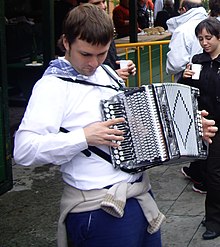Trikitixa

Trikitixa [ triki'tiʃa ], also trikititxa or eskusoinu [ eɕku'ɕoɲu ] ( Basque “hand sound”) is a Basque diatonic accordion with two normal rows of keys in diatonic assignment like the Viennese model . On the bass side there are twelve equal-tone basses.
This type of diatonic instrument has been known since the beginning of the 19th century, after it came from Italy to the Basque Country via the port city of Bilbao .
Basque music often uses the trikitixa in conjunction with singing and a tambourine . It is usually played with many quick adornments and rapid push-pull changes. Frequently, staccato - triplets used in music. The Catholic Church was originally strictly against the instrument and called it the "devil's bellows" because it was used especially by the youth for dance events.
In addition to the actual musical instrument, trikitixa can denote both the associated dance and the musical group consisting of an accordionist, tambourine, alboka or txistu player. Txistu is a longitudinal flute with three finger holes.
For example, a modern player is Kepa Junkera .
Web links
- Information page of the Basque Trikitixa Association (Basque, Spanish, French, English)